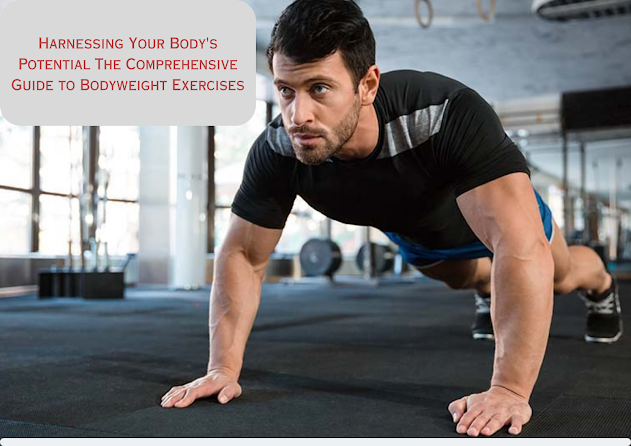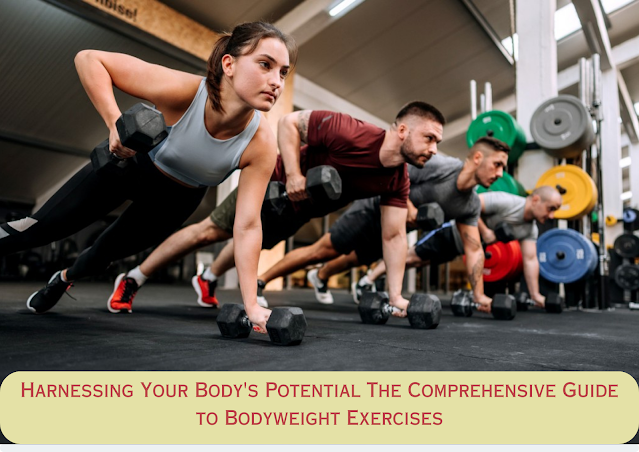Harnessing Your Body's Potential The Comprehensive Guide to Bodyweight Exercises
In a world saturated with high-tech workout equipment and complex fitness routines, bodyweight exercises stand as a timeless testament to the power of simplicity. These exercises, which rely solely on the resistance of your body, offer an effective and versatile way to build strength, enhance flexibility, and improve overall fitness. Whether you're a beginner seeking to kickstart your fitness journey or an experienced enthusiast looking to diversify your routine, this article serves as a comprehensive guide to the world of bodyweight exercises.
 |
| Harnessing Your Body's Potential The Comprehensive Guide to Bodyweight Exercises |
The Advantages of Bodyweight Exercises:
Bodyweight exercises, often celebrated for their accessibility and convenience, offer numerous benefits that cater to various fitness levels and goals.
1. Minimal Equipment Requirement:
One of the most significant advantages of bodyweight exercises is the minimal equipment required. With no need for weights or machines, you can perform these exercises anywhere—at home, in a park, or while traveling.
2. Cost-Effective:
The absence of equipment also translates to cost-effectiveness. You can achieve a full-body workout without investing in costly gym memberships or fitness gear.
3. Functional Strength:
Bodyweight exercises mimic natural movements, fostering functional strength that translates to real-life activities. This strength supports improved posture, better balance, and enhanced everyday performance.
4. Customizable Intensity:
Bodyweight exercises allow you to adjust the intensity to match your fitness level. Whether you're a beginner or an advanced athlete, modifying the exercises makes them suitable for everyone.
5. Versatility:
The realm of bodyweight exercises is vast and varied, encompassing movements that target different muscle groups and fitness components. This versatility prevents workout plateaus and encourages continual progress.
6. Improves Core Stability:
Many bodyweight exercises engage the core muscles, contributing to improved core stability and balance.
7. Enhances Flexibility:
Several bodyweight exercises, such as yoga and calisthenics, emphasize flexibility and mobility. Regular practice can lead to increased flexibility and a greater range of motion.
Foundational Bodyweight Exercises:
Before delving into specific exercises, it's essential to master foundational movements that form the basis for more advanced routines.
1. Squats:
Squats target the lower body, primarily the quadriceps, hamstrings, and glutes. Keep your feet shoulder-width apart, engage your core, and lower your hips as if sitting back in a chair. Ensure your knees align with your toes and return to the starting position.
2. Push-Ups:
Push-ups are effective for upper body strength, particularly the chest, shoulders, and triceps. Begin in a plank position, lower your body by bending your elbows, and push back up. Modify by performing knee push-ups or incline push-ups against a surface.
3. Lunges:
Lunges work the lower body, targeting the quadriceps, hamstrings, and glutes. Step one foot forward, lower your hips into a lunge position, and return to the starting position. Alternate legs.
4. Planks:
Planks engage the core muscles, supporting core stability and overall strength. Begin in a push-up position but with your weight on your forearms. Keep your body in a straight line from head to heels.
5. Glute Bridges:
Glute bridges target the glutes and lower back. Lie on your back with knees bent and feet flat on the floor. Lift your hips, engaging your glutes, and lower back down.
6. Dips:
Dips primarily target the triceps and shoulders. Find a stable surface, like parallel bars or a sturdy chair. Lower your body by bending your elbows, then push back up.
7. Pull-Ups or Inverted Rows:
These exercises target the upper back, biceps, and shoulders. If pull-ups are challenging, start with inverted rows using a suspension trainer or a sturdy bar.

Harnessing Your Body's Potential The Comprehensive Guide to Bodyweight Exercises
Creating a Balanced Bodyweight Workout:
To create a well-rounded bodyweight workout, combine exercises that target different muscle groups and movement patterns. Here's a sample full-body workout routine:
Warm-Up:
Perform 5-10 minutes of light cardio, such as jogging or jumping jacks, to increase blood flow and warm up your muscles.
Circuit:
Perform each exercise for the prescribed number of repetitions or time, then move to the next exercise without rest. After completing the circuit, rest for 1-2 minutes before repeating.
Squats: 3 sets of 15 reps
Push-Ups: 3 sets of 10 reps
Lunges: 3 sets of 12 reps (each leg)
Planks: 3 sets of 30 seconds
Glute Bridges: 3 sets of 12 reps
Dips: 3 sets of 8 reps
Inverted Rows: 3 sets of 10 reps
Cool Down:
Finish your workout with gentle stretching to improve flexibility and reduce muscle tension.
Progression and Modifications:
As your strength and fitness level improve, consider these methods to progress your bodyweight exercises:
1. Increase Repetitions: Gradually increase the number of repetitions or duration of each exercise to challenge your muscles further.
2. Modify Movement Difficulty: Progress to more advanced variations of exercises. For example, progress from knee push-ups to standard push-ups or from assisted pull-ups to unassisted pull-ups.
3. Add Props: Incorporate equipment like resistance bands, stability balls, or suspension trainers to add variety and intensity to your workouts.
4. Incorporate Plyometrics: Plyometric exercises, like squat jumps or burpees, add an explosive element to your routine and elevate your heart rate.
5. Combine Exercises: Create compound movements by combining exercises. For instance, perform a squat followed by a shoulder press.
Safety Considerations:
While bodyweight exercises are generally safe for most individuals, it's essential to consider safety precautions:
1. Proper Form: Maintain proper form throughout exercises to prevent injury and maximize effectiveness.
2. Warm-Up: Always warm up your muscles before engaging in intense bodyweight exercises.
3. Listen to Your Body: Pay attention to your body's signals. If an exercise causes pain or discomfort, stop immediately.
4. Gradual Progression: Progress slowly to avoid overexertion and injury. Gradually increase intensity, repetitions, or exercise difficulty.
5. Consult a Professional: If you have any medical conditions or concerns, consult a healthcare professional or fitness expert before starting a new exercise regimen.
Bodyweight exercises epitomize the elegance of simplicity in fitness. They empower individuals to harness their body's potential, build strength, and achieve their fitness goals without the need for elaborate equipment. From foundational movements to advanced variations, bodyweight exercises offer a versatile and effective means of enhancing physical fitness and overall well-being. Incorporate these exercises into your routine, tailor them to your fitness level, and embark on a journey of strength, flexibility, and vitality.





.png)


0 Comments